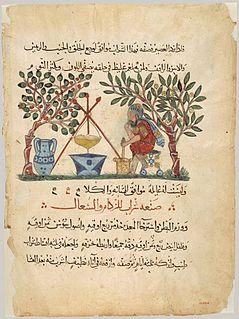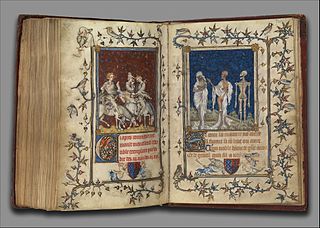 W
WAmarna letter EA 15, titled Assyria Joins the International Scene is a shorter-length clay tablet Amarna letter from Ashur-uballit I of the Land of Assyria,. He addresses the Pharaoh in line 1, the "King (of) Land Miṣri-(Egypt)", thus the use of "Land (of) Assyria".
 W
WAmarna letter EA 153, titled Ships on Hold, is a short-length clay tablet letter from Abimilku of the island of city-state Tyre.
 W
WThe Belles Heures of Jean de France, Duc de Berry, or Belles Heures of Jean de Berry is an early 15th-century illuminated manuscript book of hours commissioned by the French prince John, Duke of Berry, around 1409, and made for his use in private prayer and especially devotions to the Virgin Mary. The Belles Heures is one of the most celebrated manuscripts of the Middle Ages and very few books of hours are as richly decorated as it.
 W
WThis grass-style Chinese calligraphy titled Biographies of Lian Po and Lin Xiangru was written by the famous calligrapher Huang Tingjian (1045–1105) in Northern Song Dynasty (960–1127). The overall handscroll is 34.3 cm in height and 2,178.4 cm in length and contains 652 identifiable Chinese characters. The manuscript was originally collected by New York art collector John M. Crawford Jr. (1909-1988), and currently collected by the New York Metropolitan Museum of Art.
 W
WThe Cloisters Apocalypse, MS 68.174 is a small French illuminated manuscript dated c. 1330. It is based on John the Evangelist's New Testament visions and apocalyptic revelation. According to Christian legend John was exiled c. 95AD to the Aegean island of Patmos, where he wrote the Book of Revelation. The book evokes John's despair and isolation while exiled, and his prophecy of events and terrors of the last days.
 W
WThe Cloisters Hebrew Bible is a Hebrew Bible codex made in the Kingdom of Castile from the early to mid-14th century, with an approximate date prior to 1366. The Metropolitan Museum of Art acquired this manuscript from the collection of Jacqui Safra from Sothebys Judaica auction in December 20, 2017.
 W
WThe Flemish Hunting Deck, also known as the Cloisters set of fifty-two playing cards and Hofjaren Jachtpakket, is a set of fifty-two playing cards owned by the Metropolitan Museum of Art, New York, United States. It is significant in that it is the only complete set of ordinary playing cards from the fifteenth century. Estimate ranges of manufacture are between 1470 and 1480.
 W
WThe Hours of Étienne Chevalier is an illuminated book of hours commissioned by Étienne Chevalier, treasurer to king Charles VII of France, from the miniature painter and illuminator Jean Fouquet.
 W
WThe Hours of Jeanne d'Evreux is an illuminated book of hours in the Gothic style. According to the usual account, it was created between 1324 and 1328 by Jean Pucelle for Jeanne d'Evreux, the third wife of Charles IV of France. It was sold in 1954 to the Metropolitan Museum of Art in New York where it is now part of the collection held at The Cloisters, and usually on display. The book is very lavishly decorated, mostly in grisaille drawings, and is a highly important example of an early royal book of hours, a type of book designed for the personal devotions of a wealthy lay-person, which was then less than a century old. It has been described as "the high point of Parisian court painting", showing "the unprecedentedly refined artistic tastes of the time".
 W
WThe Physician Preparing an Elixir is a miniature on a folio from an illustrated manuscript copy, now in the Metropolitan Museum of Art in New York of De Materia Medica, a large herbal or work on the (mostly) medical uses of plants originally written by the ancient Greco-Roman physician, Pedanius Dioscorides, in the first century AD. This page of the manuscript, dated 1224 AD, is made from paper, sized 24.8 cm wide and 33.2 cm long, and is decorated by opaque watercolor, ink, and gold detailing. It is visually split into three horizontal portions from the top of the page to the bottom; the top of the page is dominated by two lines of Arabic script, followed by the image and then five more lines of text in Arabic. The writing below the image is predominantly black with the exception of one line, which is written in red ink and is therefore highlighted to the viewer. The page is usually not on display.
 W
WThe Psalter of Bonne de Luxembourg is a small 14th-century illuminated manuscript in tempera, grisaille, ink and gold leaf on vellum. It is held in the collection of The Cloisters, New York, where it is usually on display.
 W
WThe Shahnameh of Shah Tahmasp or Houghton Shahnameh is one of the most famous illustrated manuscripts of the Shahnameh, the national epic of Greater Iran, and a high point in the art of the Persian miniature. It is probably the most fully illustrated manuscript of the text ever produced. When created, the manuscript contained 759 pages, 258 of which were miniatures. These miniatures were hand painted by the artists of the royal workshop in Tabriz under rulers Shah Ismail I and Shah Tahmasp I. Upon its completion, the Shahnameh was gifted to Ottoman Sultan Selim II in 1568. The page size is about 48 x 32 cm, and the text written in Nastaʿlīq script of the highest quality. The manuscript was broken up in the 1970s and pages are now in a number of different collections around the world.
 W
WUncial 0162, ε 023, is one vellum leaf of a Codex containing The Gospel of John in Greek. It has been paleographically assigned a 3rd or 4th century CE date.